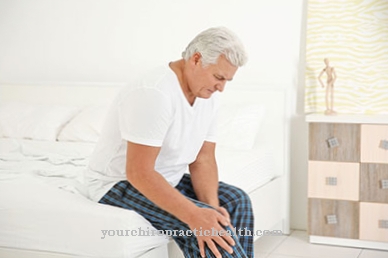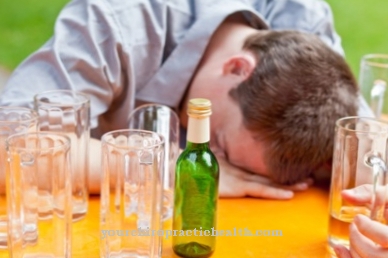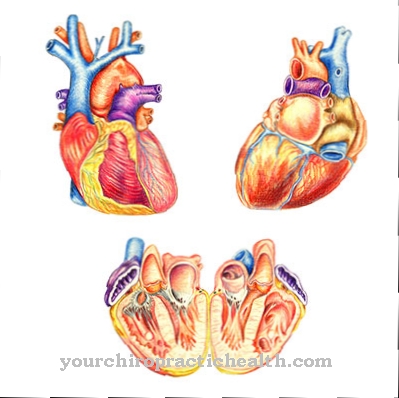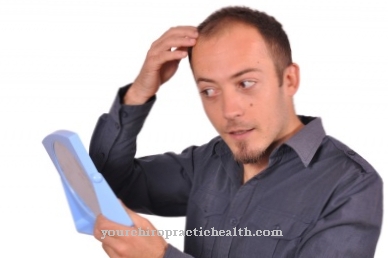The posture of humans is completely different from the posture of vertebrates, which (mostly quadrupeds) always use their upper extremities to move. Some vertebrates are able to walk or stand upright at times, but walking upright is by no means their only mode of locomotion. When it comes to keeping animals, the apes are closest to humans, but they also use their arms to move in the branches of the trees or on the ground. His front limbs are considerably longer and the trunk posture is much more forward leaning than in humans.
How the body & spine work
Our body, on the other hand, is designed in such a way that the legs are only there for walking and standing, while our arms and hands do all the daily work, both large and small. So it happens that the bones and joints of the legs are primarily geared towards supporting and locomotion functions, but the arms and hands can perform much more extensive and finer movements. A basic requirement for the correct interaction of the various organs of the human postural and musculoskeletal system is a free and upright posture.
For the posture, which depends on many factors, the condition of the spine and its active and passive holding devices are of decisive importance. The shape of our spine is largely determined by the position of the pelvis, which is usually slightly inclined forward.
If the spine were fully extended, it would tilt forward and attack the upper body in the same direction. Our body is kept upright by the fact that the spine in the lumbar section bends backwards in a gentle curve, here thus describing a narrow forward curve (lordosis) and is slightly curved backwards above the lumbar spine.
Development of the spine in children
This backward curvature (kyphosis) of the thoracic spine is in turn compensated for by a forward curvature of the cervical spine that supports the head. The normal spine has - seen from the side - a slightly S-shaped curved shape. Seen from behind it forms a straight vertical line. Man is by no means upright from birth. He only has to acquire it in the first two decades of life. In a child in the womb, the spine is arched backwards, the chin rests against the rib cage, and the legs are sharply bent in the hip joints.
This prenatal position can still be clearly recognized in infancy. The cervical spine only curves slightly forward when the baby is two to three months old and lifts its head upwards in the prone position. When the child sits at the age of about six months, later makes the first attempts to stand and finally starts to walk, the spine continues to straighten up. But mostly a child does not have an upright posture until they are two years old. However, this is subject to manifold changes in the following years.
As we know, a person's posture is largely dependent on the condition of their muscles and ligaments. We differentiate between a rest position and a work position. While the ligaments keep the resting body upright, the core muscles ensure that the body is erected in a working position. The muscles not only serve to straighten the spine, but also help you move.
The abdominal muscles act as antagonists to the back muscles, acting from the pelvis via the rib cage from the front on the spine. The development of the back and abdominal muscles is therefore of crucial importance for a normal posture. If the developmental tendencies of the muscles are inhibited by external influences, muscle weakness is inevitable. This in turn affects posture and physical performance.
You can find your medication here
➔ Medicines for back painDevelopmental disorder of the muscles
Therefore, everything must be done to promote the development of the muscles and the entire postural and locomotor system in every way. The principle "If you rest, you rust" already applies in childhood. Muscles that are not used on a regular basis do not grow with the patient and remain inefficient. Sections of the body that are immobilized for a long time, for example with a plaster cast, regularly show a loss of their musculature and lag behind in growth.
Excessive stimuli also lead to functional disorders, because all organs only work properly if they are stimulated by external or internal influences in a way that is conducive to their normal function. So we have to constantly watch that the growing organism is only affected by stimuli that serve as normal a development as possible.
Bones, ligaments and muscles of the spine should therefore be used to a reasonable extent, because normal function is always the best incentive for healthy development. One must take into account that the growing organism is more irritable than the fully grown one.
Spine growth & posture
In the 5th to 7th year of life and in the 11th to 15th, in the times of increased length growth, the irritability of the tissues is particularly increased, and therefore there is a risk of overstraining in these parts of life. These are the years in which the child goes to school and the young person moves on to work.
Accelerated growth during puberty is - as is generally known - quite normal, but growing too quickly at this developmental age can very easily lead to a reduction in the performance of the supporting tissue, especially if the biologically determined growth tendency of the bone system is not associated with muscular requirements .
The supporting tissues then do not keep pace with the increased length growth and are therefore quickly overwhelmed. The young person is then no longer able to maintain a normal upright posture; and posture deterioration or posture damage occurs. Constant overuse quickly leads to permanent damage.
Which stimuli damage the child's body and which stimulate it in its development cannot be said with absolute certainty. However, we know from experience that continuous stress of all kinds is harmful to a child. Short-lasting, medium-strength stimuli, the intensity of which can be increased over time, are better.
Symptoms, ailments & signs
Bad posture and bad posture in children and adolescents need not necessarily lead to symptoms quickly. Often it is the parents or the pediatrician who becomes aware of the posture damage. Even if there are no specific complaints, it makes sense to treat the postural damage.
If the postural error is not corrected, the body will assume an unfavorable or physiologically permanently impossible position, which will sooner or later lead to pain. Above all, back pain that does not result from an accident is often a sign of postural damage that has already existed for a long time. Neck pain or headaches can also result from untreated postural problems.
Many children and adolescents show poor posture over a long period of time and still feel no symptoms. However, since the body cannot maintain a bad posture for years, symptoms can still occur in adulthood.
Evidence of postural damage can be found particularly in children and adolescents who do little sport, have appropriately trained muscles and sit a lot. A round back, a bent forward posture and a shuffling, feeble-looking gait are also the first signs of a posture problem and should be discussed with the pediatrician as soon as possible.
diagnosis
It goes without saying to always proceed individually, because children of one age group can be very different in their development. All deviations from normal posture that persist over a long period of time are referred to as poor posture and sooner or later lead to premature wear of the bones, joints and ligaments of the spine. Muscle strength is used up prematurely, so that people age quickly and the feared early disability can occur. For this reason alone, all posture damage must be recorded as early as possible, because only then can it be effectively combated.
Detecting bad posture at an early stage is often very difficult, because only in the rarest of cases does it cause pain at the beginning. At the beginning they develop slowly and imperceptibly. Only when they have reached a certain level do pulling or dull back pain occur, which sometimes radiate into the legs.
Unfortunately, then it is often too late for a complete recovery. We must therefore constantly monitor our children and adolescents in order to be able to identify and combat postural deterioration or posture damage in good time. The deviations from the normal posture can be very different.
Hollow back
One speaks of a "hollow back" or "hollow back" when the curvatures of the spine as described above are reinforced. This pronounced backward curvature of the spine also shows a more pronounced hollow back. Bulges in the normal S-shaped spine are not uncommon. Furthermore, the entire spine can be bent so that it extends backwards, with the forward curvature of the lumbar spine being completely eliminated and included in the overall arch. This shape of the spine is known as the "totally round back".
Flat back or flat back & sloping shoulders

An excessively straight position of the spine, in which all curves are flattened, is also pathological and is referred to as a "flat back". Physical changes that result from the relaxation of those muscles that straighten the spine also belong to the area of postural damage. In this context, sloping shoulders - where both shoulders can be unevenly high - and protruding shoulder blades should be mentioned. If the abdominal muscles relax, because this phenomenon is also a loss of posture, the stomach sags forward. The upper body is shifted backwards to compensate for this, which in turn makes the hollow back more pronounced.
Signs of poor posture can vary in intensity. If it is still possible for the child or adolescent to consciously straighten himself up from this slack to a normal posture by tensing his muscles, then we speak of a "posture error" that is still relatively easy to combat.
Treatment looks much more difficult when it is no longer possible to stand up in response to encouragement. In such a case, it must be determined whether a normal shape can be restored or not by external forces, for example by pressing the hand against the relevant spinal column sections. If that is possible, it is a "positional error".
If, however, it is no longer possible to change the pathological shape of the spine even through external forces, then there is a "form defect" which, unfortunately, can generally no longer be remedied even by intensive medical treatment. Further aggravation must then be counteracted intensively by appropriate treatment. The transitions from the posture error to the positional error to the formal error are fluid. The different prognoses for these individual degrees of severity make it necessary to identify and treat these pathological changes as early as possible.
When should you go to the doctor?
Bad posture and bad posture in children and adolescents must usually always be examined and treated by a doctor. In this way, further complications and complaints in the adult age of the patient can be avoided. A doctor should be consulted if the parents discover a bad posture in the child. In many cases this bad posture is also associated with pain and is intended to suppress it.
If the incorrect posture does not go away on its own within a short period of time, a doctor should definitely be consulted. A visit to the doctor is also necessary if the parents notice a defective development in the child, whereby the spine in particular can show an unusual curvature. Likewise, pain in the muscles and ligaments suggests poor posture and poor posture in children and adolescents and should be investigated.
The first examination and diagnosis of bad posture in children and adolescents can be done by a pediatrician or a general practitioner. The treatment itself usually takes place with a specialist or with the help of various exercises and therapies. An early diagnosis of this damage has a very positive effect on the further course of the disease.
Doctors & therapists in your area
Treatment & Therapy
In the treatment of poor posture or postural damage, active measures are predominantly in the foreground today, that is, a conscious training of the muscles that causes a normal upright posture. In the case of simple posture errors, muscle-strengthening gymnastics is generally sufficient, which is best performed in gymnastics groups.
With small children, these exercises have a playful character, whereby all relevant muscle groups are systematically trained through skillful physiotherapy. During this exercise, a sufficiently long break must be made between the individual exercises.
Children who are at risk of posture should also sleep hard and flat, as often as possible on their stomachs, as this strengthens the back muscles. Swimming is also of particular importance. All children and adolescents with a positional error require targeted orthopedic treatment, with special gymnastic and orthopedic exercises being carried out on a case-by-case basis.
There are numerous specific orthopedic treatment methods for this, for example Klapp’s crawling exercises, which lead to excellent results. However, all of these exercises must be done regularly and consistently over a long period of time.
Dry brushing the back is also beneficial as it stimulates blood flow to the muscles. The formal defects of the child's and adolescent spine are treated in the same way. Under certain conditions, surgical treatment may be necessary, especially as the condition progresses.
Finally, it should be emphasized once again that in children and adolescents, all deviations from the normal shape of the spine urgently require medical treatment, even if they do not cause any pain. Otherwise permanent damage can occur very quickly, which will significantly impair performance in the rest of life. If posture damage is detected early on, it can be combated effectively. However, the chances of recovery decrease the later the treatment begins.
Outlook & forecast
Bad posture and bad posture seem to be an increasing problem in children. As soon as parents themselves notice an abnormal posture, this should be discussed with the pediatrician. This can decide whether further diagnostics and, if necessary, therapy are indicated. The prognosis of a bad posture is better, the earlier the problem can be recognized and treated in a targeted manner.
Posture errors that persist over a long period of time creep in and are more difficult to correct. This in turn results in the problem that long-standing posture errors can also lead to serious posture damage. Bad posture, if persisted long enough, can damage the spine, tendons, and ligaments. These can be painful for the child and lead to unfavorable relieving postures.
On the other hand, existing damage also has an overall poorer prognosis of disappearing completely. If therapy is initiated at an early stage, there is a good chance that an ergonomically correct posture can be achieved again, especially with children, who are more malleable than adults in terms of spine and erection. This is also important because postural damage in adults, which has resulted from posture errors lasting for decades, can often hardly be corrected and has left permanent physical damage.
You can find your medication here
➔ Medicines for back painAftercare
In the event of postural damage and posture errors in children and adolescents, some aftercare measures are available to those affected. In any case, the patterns that led to this damage must be avoided in order not to burden the body again. An early diagnosis of postural damage and posture errors in children and adolescents is also very important, so that parents in particular have to pay attention to the symptoms and complaints and then contact a doctor.
In most cases, these complaints are treated with various exercises or physiotherapy. It is very important that the parents encourage the children to do these exercises and that the children do the exercises regularly. They can also be performed in your own home, which may speed up healing.
Parents should also instruct the children in a correct and healthy posture and try to adhere to it. In the case of pain caused by postural defects and postural errors in children and adolescents, painkillers can be taken, but excessive and long-term use should be avoided. In general, a healthy lifestyle with a healthy diet and sporting activities also have a positive effect on these complaints.
You can do that yourself
Damage to posture can in many cases be corrected and thus minimized in a partnership with the children and adolescents through the influence of legal guardians. If there is a friendly relationship with a lot of understanding, calm and informative conversations can be held with the adolescent.
Educational work shows the offspring the importance and explosiveness of posture errors. Advice can be given on what a healthy posture should look like, alternative postures can be practiced and implemented together. In addition, sporting activities help to build up muscles and stabilize the skeletal system.
Carrying heavy objects should be prohibited to children and young people. Hard physical labor should also be avoided. If the legal guardians do not have access to the child or if the adolescent is going through a phase of defiance, adults who have the child's trust should take over the educational work.
These can be trusted teachers, doctors or people with a role model from the local area. The distance between the desk and the chair of a growing person should be adjusted to current requirements at regular time intervals. It is important to ensure an ergonomic workplace, as children and young people in particular spend a lot of time in front of a computer.
The selection of healthy and suitable footwear as well as means of transport that are continuously adapted to the height of the child should be used.



























